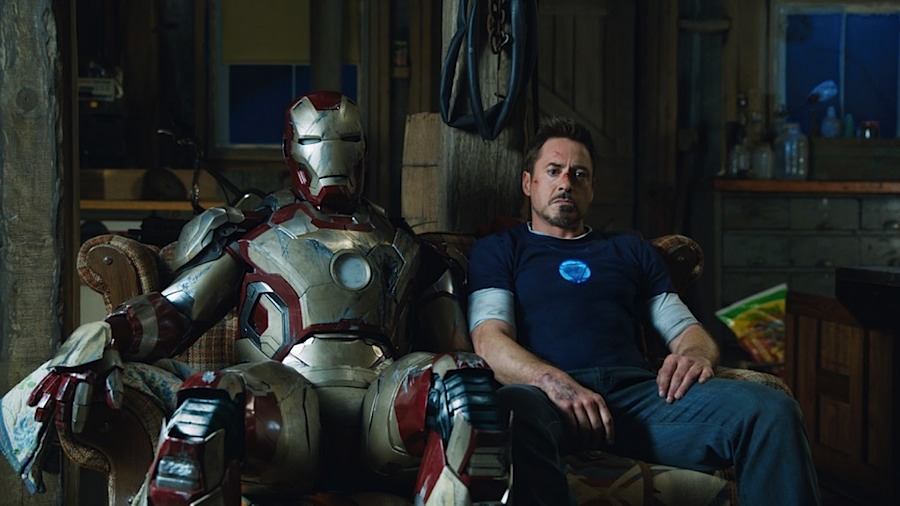I walked into Iron Man 3 with some trepidation. Iron Man 2 was deeply flawed and early previews that suggested new writer/director Shane Black was aping Christopher Nolan’s “Dark Knight” style weren’t encouraging. My favorite parts of the first two films are the awkward moments of human interaction that are the Jon Favreau touch, and I was worried that the third film would be a self-serious take on terrorism, technology, and hubris. Just another generic over-color-corrected superhero movie.
Well, I’m happy to report that I was wrong. Iron Man 3 is great. Shane Black takes the fun, snarky, intelligent characters Favreau developed and successfully places them in a tightly scripted thriller with some truly pulse pounding action sequences.
(Mild storyline spoilers ahead. Nothing you couldn’t already infer from the trailers. Anything not in the trailers is whited out.)
One reason Iron Man 3 works as well as it does is that it’s a direct sequel to The Avengers, dealing with the emotional fallout that The Avengers didn’t have time for. The people of Earth are having a collective existential crisis in response to the existence of malevolent aliens (and Norse gods and giant green rage monsters) and Tony Stark (Robert Downey Jr.) is right there with them. Nightmares of his experiences are keeping him up at nights and giving him debilitating panic attacks, and Tony deals with his trauma in his usual way: denial and obsessive tinkering with the Iron Man armor. This emotional crisis could not come at a worse time, as super terrorist The Mandarin (Ben Kingsley) launches a series of attacks against America, including a strike against Tony that destroys his home and strips him of his allies.
Iron Man 3 throws a lot of narrative balls into the air—Pepper Potts (Gwyneth Paltrow) is dealing with the pressures of being both the full time CEO of Stark Industries and Tony’s live-in girlfriend, the U.S. military has rebranded “War Machine” James Rhodes (Don Cheadle) as “the Iron Patriot” in a desperate attempt to keep up with the Avengers, rival think tank A.I.M., headed by Aldrich Killian (Guy Pierce) introduces EXTREMIS, a new medical treatment for regrowing missing limbs—and early on the film threatens to become the hot mess of competing plotlines that Iron Man 2 became. But Black and writing partner Drew Pearce weave the disparate plot threads together into a satisfying story. It’s not to much of a surprise that Killian is working with the Mandarin, since A.I.M. is a dead giveaway to Marvel fans, and also he’s played by Guy Pierce at his oiliest.
Despite the more thriller oriented plot, the dialogue retains the naturalistic, comedic timing that made the first films so much fun. After four films, Downey, Paltrow, and Paul Bettany as Stark’s snarky AI butler Jarvis have their characters down pat. They know how their characters think and interact, a playful combination of insults, double talk, and willful ignorance. Iron Man 3 features larger and more proactive roles for Pepper and Jarvis, as well as for Rhodey and Happy Hogan (Jon Favreau cheerfully reprising his role as Tony’s somewhat redundant head of security). Even newcomer Ty Simpkins, playing a young kid Tony teams up with after losing everything, understands the way to deal with Tony is to throw his quick talk routine back in his face.
Pierce is wonderfully smarmy as nerd turned stud Killian, what Sam Rockwell’s character from Iron Man 2 would have been if he had actually been effective. But Kingsley is the scene stealer. The Mandarin is a problematic character at best. On the one hand, he’s Iron Man’s Doctor Doom, an archvillain who uses scientific genius and ten rings of power to take over the world, and his existence was hinted at back in Iron Man. On the other hand, everything about the character, including his nom du guerre, is steeped in the yellow peril/red menace paranoia of the sixties. To make the character anything other than a racist stereotype requires more than just turning a Fu Manchu stand-in into a bin Laden stand-in. Kingsley (and Black) manage to thread that needle by acknowledging the racism inherent in the creation of the character, but to say how would spoil a lot of the fun. However, I can say that the Mandarin provides Iron Man with something that’s been missing from the series so far: an honest to goodness supervillain. By the end, Tony is fighting [highlight for spoilers] a firebreathing superstrong regenerating badass covered in dragon tattoos (a combination Human Torch/Wolverine/Hulk), which is a step up from another dork in an evil Iron Man suit. [end spoilers]
Perhaps Iron Man 3’s greatest strength is its action scenes. We just saw Iron Man go toe to toe with the god of thunder in The Avengers, so you’d think it would be difficult to come up with challenges for Tony Stark that are both believable and engaging. Black gets around this problem by a) keeping Tony out of his suit for most of the movie, and b) imperiling everyone around Tony. We’re rarely led to believe that Tony won’t make it to The Avengers 2, but the same can’t be said for Pepper, Rhodey, or President Ellis (named after Warren Ellis, author of the Extremis storyline on which the movie is heavily based).
While certainly worlds better than Iron Man 2, I can’t say Iron Man 3 is as much fun as Iron Man or The Avengers. It is too concerned with the physical and emotional consequences of superheroics to be a pure popcorn flick. On the other hand, it’s still a really good movie, as good or better than Thor or Captain America, so the change in tone is probably a good sign for Marvel Studios movies going forward. Iron Man 3 shows that different types of stories can be told using the same characters in what is recognizably the same universe, meaning that there is life in this franchise for years to come.










